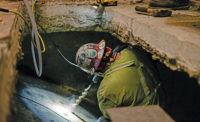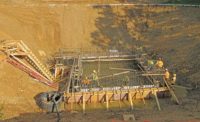As the dust from a tumultuous 2020 settles and threatens to kick up again, ENR MidAtlantic’s Top Contractor survey reveals that the firms taking part in this year’s ranking ended up being no worse for wear from a revenue standpoint.
The 76 firms responding to the survey reported a combined $29.39 billion in MidAtlantic regional revenue in 2020. That was down 1.4% from the total posted by the 70 firms ranked last year.
The figures count regional revenue billed in Delaware, Maryland, Pennsylvania, Virginia, West Virginia and the District of Columbia.
This year’s top 10 firms recorded $14.54 billion in combined revenue. That figure trailed the $14.69 billion posted by last year’s top 10 by 1%.
Whiting-Turner Contracting Co. finished first for the third consecutive year. The company’s 9.08% revenue increase, to $3.35 billion, follows its 17.3% revenue gain in the previous year. Clark Construction Group was once again the runner-up, with approximately $2.6 billion for the third straight year. The No. 3 slot goes to HITT Contracting Inc.—which was also third on last year’s list. The firm reported $1.60 billion in revenue, a 7.75% decrease from the previous year.
Executives from three MidAtlantic contractors discussed current market conditions with ENR MidAtlantic. The leaders also offered predictions for the market’s future performance. Responses emailed in early August came from The Lane Construction Corp., No. 16, with $466.05 million in revenue and LF Driscoll/Structure Tone, No. 12, with $684.47 million in revenue. Responses have been edited for space and clarity.
|
Related Link |
Do you believe the Biden administration is having an impact on design and construction in the MidAtlantic?
Josh Goyne, executive vice president – chief operating officer construction, The Lane Construction Corp.: The Biden administration has brought a renewed energy to prioritizing the nation’s infrastructure issues. It’s clear that solving the infrastructure crisis is a top issue for the administration and recently seems to be gaining bipartisan support within Congress. As a bill inches closer to passing [the House], it will be interesting to see how the money is allocated across various entities for funding future infrastructure projects. A bill such as this will also exacerbate challenging labor markets already seen in many of the large metropolitan cities throughout the U.S.
Which sectors have offered the biggest opportunities in the MidAtlantic? Do many sectors have tremendous opportunities right now?
Goyne: Transportation, water resources and commercial construction are all sectors that have seen strong growth recently in the MidAtlantic areas.
Mack Stulb, president, LF Driscoll: Health care has certainly been and continues to be one of our strongest sectors. In response to COVID-19, we’re seeing health care clients implement new standards and regulations, which has resulted in the need to renovate existing facilities. The life sciences sector has also heated up considerably as the demand for research, labs and manufacturing spaces rises.

IMC Construction, No. 23 with $389.70 million in revenue, is building the 19-story tower at 2222 Market Street in Philadelphia.
Photo by Parkway Corp., Courtesy of IMC Construction
Which sectors have cooled down in the MidAtlantic?
Goyne: We haven’t seen many sectors that have slowed down. Certainly, some sectors were affected more than others due to COVID-19, but those appeared to have been temporary slowdowns that have already picked back up.
Stulb: The hospitality and higher education markets have both cooled. The corporate office sector is so tenant-driven that it’s still hard to say where things will go.
What key innovations helped you boost productivity or other metrics in the MidAtlantic?
Goyne: We continue to heavily invest in new technologies to automate and refine our current processes. Although COVID presented many new challenges, it also created many opportunities to utilize technology to solve manual processes. Many activities, such as timecard approvals, invoicing and payment processing have been changed to allow for a more streamlined process.
Stulb: Prefabrication is becoming more of a focus for us, as is maintaining our focus on quality. The Safety 360 initiative we have lived by for several years now was really critical to developing the mindset we needed to respond to the adjustments we’ve had to make due to the pandemic.
Where do you think the industry in the region is headed in the next year?
Goyne: It’s hard to believe that a little more than a year ago nearly the entire industry was quite concerned about whether projects would continue and wondered what we would do if projects were delayed or terminated. Today, the focus has drastically shifted to more of a “how will we handle” the pipeline of work with the current and future projects in our pipelines. It’s amazing to see such a shift in priorities in such a short amount of time.
Stulb: We predict that the rest of 2021 will continue to bring new opportunities. Health care systems are reevaluating how they want to operate with the increased use of telemedicine and the trend to deliver health care to the patient rather than vice versa. COVID also accelerated the trend of mergers and consolidations of health systems, and we expect that trend to continue.






Post a comment to this article
Report Abusive Comment